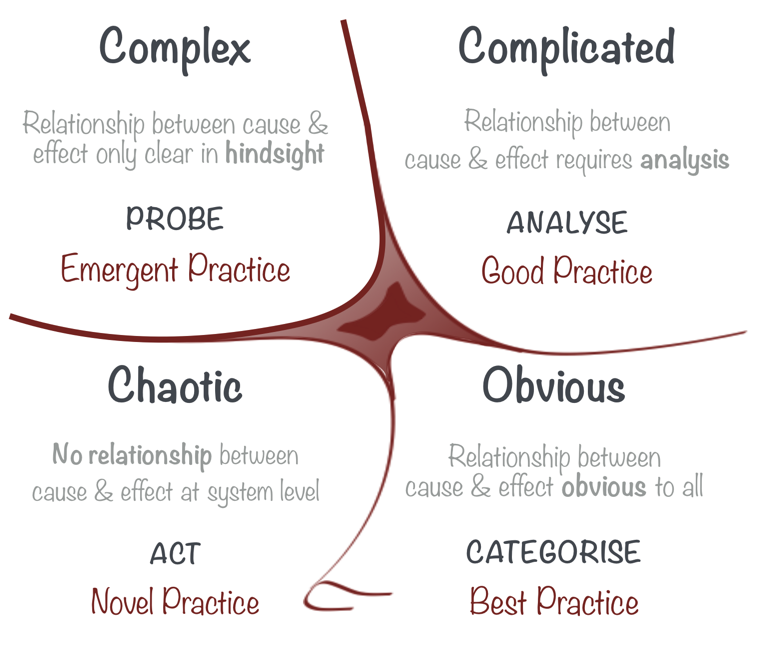(Chinese Translation: Scrum:什么是Cynefin框架?) (日本語)
While Scrum may be an effective framework for many kinds of projects, it is important for you to realize that it is not the panacea for all kinds of projects — it can be an excellent solution for a lot of situations in your organization but it may not be the proper answer in some scenarios. A framework known as Cynefin help us to make sense of situations that we would encounter in project scenarios.
The essence of Scrum method is to enable the entire team to consistently deliver quality workmanship through a rigorous yet flexible development process in situations in which requirements are not fully known or trustworthy. Self-organization allows the project team to produce accurate and precise solutions while the market constraints are subject to unpredictable change.
Cynefin Framework?
The Cynefin framework, a Welsh word for habitat, is a conceptual framework used to aid decision-making created in 1999 by Dave Snowden. It offers five decision-making contexts as:
- simple,
- complicated,
- complex,
- chaotic, and
- disorder
Cynefin Framework helps managers to identify how they perceive situations and make sense of their own and other people’s behavior. It draws on research into systems theory, complexity theory, network theory and learning theories.

Take a look at these possible disorder scenario domains in your projects to find out whether Scrum would work for you or not:
- Simple
In the simple domain we are in an ordered system where the relationship between cause and effect exists, is predictable in advance and is self evident or obvious to any reasonable person.
We apply best practices and the approach is to:-
SENSE — CATEGORIZE — RESPOND
- Sense — See what’s coming in
- Categorize — Make it fit predetermined categories
- Respond — Decide what to do
Simple scenarios are situations wherein everyone can see the cause and effects — people know what the right answer is. This type of domain exists is best for reproducing products over and over again since there are steps that you can repeat to solve existing problems.
While Scrum can be a way to address this type of scenario domain, you can achieve faster and more certain results with the assembly line frame work since you have legitimate best practices anywhere.
2. Complicated
We apply good practice and the approach is to:-
SENSE — ANALYSE — RESPOND
- Sense — See what’s coming in
- Analyse — Investigate or analyse, using expert knowledge
- Respond — Decide what to do
Complicated scenarios are often dominated by experts in order to ensure good practices in a project. While there is a possibility of having multiple answers, having an expert to diagnose problems would be more efficient in addressing scenarios that have multiple possible outcomes. Scrum may be used to resolve scenarios like this, but of course, it may not always be the best framework to use.
For example, if you need to adjust parameters in optimizing performance, you may know the best course of action when you assemble experts to take a look at the situation, check out available options, and generate a response based on their experience of what a good practice should be. Complicated scenarios are best resolved through quantitative and tactical approaches like Six Sigma.
3. Complex
PROBE — SENSE — RESPOND
- Probe — Experimental input
- Sense — Failures or successes
- Respond — Decide what to do ie. amplify or dampen
Complex problems make you realize that there are more unpredictable results than what you can expect from your approaches, and in this domain, you are more likely to get the right answer when you correct a mistake or hindsight.
This requires you to explore as much as you can about the problem, inspect what is working or not, and then adapt based on what you have learned. This is also the domain that you would encounter when you are trying to make innovations or making enhancements for previous projects that require better features.
This is the domain where Scrum truly shines, since complex situations make use of your ability to probe the situation and inspect what you can do in a particular time-frame. When you learn a better method in the process of iteration, then you can adapt that on the next iteration time-box.
4. Chaotic
We discover novel practice and the approach is to:-
ACT — SENSE — RESPOND
- Act — Attempt to stabilise
- Sense — Failures or successes
- Respond — Decide what to do next
Emergent practice, behaviour or order results and the approach is to:-
These kinds of scenarios require a solution right away — when your project goes to the chaotic domain, it means that you are experiencing a crisis that your need to put out before you experience any additional harm and to go back to the state of order. This is the type of scenario that you experience when someone files a lawsuit or the only expert that you know is nowhere to be found.
Scrum is not suitable in addressing these kinds of scenarios since you do not have the luxury to prioritize backlogs and what you need to do during the next situation. When chaos hits, you need to have someone with full authority to take charge and act ASAP.
5. Disorder
Disorder domains happen when you become uncertain of what stage you are in in your project and you do not know if any plans are working or not. This is a very dangerous situation that you need to get out of immediately.
This requires you to break the situation apart and look at its components to know if they fall into any other categories to see what kind of approach you should use to solve the situation and go back to making progress. You can see that there is no point in adapting Scrum in this kind of situation until you properly categorize the components of the problem.

